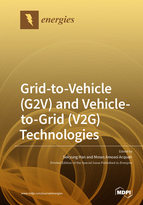Grid-to-Vehicle (G2V) and Vehicle-to-Grid (V2G) Technologies
A special issue of Energies (ISSN 1996-1073). This special issue belongs to the section "E: Electric Vehicles".
Deadline for manuscript submissions: closed (31 May 2020) | Viewed by 35485
Special Issue Editors
Interests: power system analysis and modeling; distributed power control; vehicle-to-Grid; energy management system (EMS) design
Special Issues, Collections and Topics in MDPI journals
Interests: smart grid; energy management system; vehicle-to-grid (V2G); big data; machine learning; optimization
Special Issues, Collections and Topics in MDPI journals
Special Issue Information
Dear Colleagues,
In recent years, there has been a global outcry for the decarbonization of energy systems to provide a secure and sustainable energy supply while cutting down on greenhouse gas emissions (GHGs) in an effort to avoid global warming.
With the explosion in use of battery energy storage, electric vehicles (EV) are considered an efficient eco-friendly means of transportation. They also play a role through their interaction with electricity grids, delivering power as well as controlling the charging rate for a faster charging time.
EVs are able to meet this role due to grid-to-vehicle (G2V) and vehicle-to-grid (V2G) operation providing bidirectional power flow to tackle the twin challenges of faster charging and providing ancillary services to the grid.
This Special Issue entitled “Grid-to-Vehicle (G2V) and Vehicle-to-Grid (V2G) Technologies” invites articles on current state-of-the-art technologies and solutions in G2V and V2G, including but not limited to the operation and control of gridable vehicles, energy storage and management systems, charging infrastructure and chargers, EV demand and load forecasting, V2G interfaces and applications, V2G and energy reliability and security, environmental impacts and economic benefits, as well as demonstration projects and case studies in the aforementioned areas.
Articles that deal with the latest hot topics in V2G are of particular interest, such as V2G and demand-side response control technique, smart charging infrastructure and grid planning, advanced power electronics for V2G systems, adaptation of V2G systems in the smart grid, adaptation of smart cities for a large number of EVs, integration, and the optimization of V2G systems, utilities and transportation assets for advanced V2G systems, wireless power transfer systems for advanced V2G systems, fault detection, maintenance and diagnostics in V2G processes, communications protocols for V2G systems, energy management system (EMS) in V2G systems, IoT for V2G systems, distributed energy and storage systems for V2G, transportation networks and V2G, energy management for V2G, smart charging/discharging stations for efficient V2G, environmental and socio-economic benefits and challenges of V2G systems, and building integrated V2G systems (BIV2G).
Prof. Dr. Sekyung HanDr. Acquah Amoasi Moses
Guest Editors
Manuscript Submission Information
Manuscripts should be submitted online at www.mdpi.com by registering and logging in to this website. Once you are registered, click here to go to the submission form. Manuscripts can be submitted until the deadline. All submissions that pass pre-check are peer-reviewed. Accepted papers will be published continuously in the journal (as soon as accepted) and will be listed together on the special issue website. Research articles, review articles as well as short communications are invited. For planned papers, a title and short abstract (about 100 words) can be sent to the Editorial Office for announcement on this website.
Submitted manuscripts should not have been published previously, nor be under consideration for publication elsewhere (except conference proceedings papers). All manuscripts are thoroughly refereed through a single-blind peer-review process. A guide for authors and other relevant information for submission of manuscripts is available on the Instructions for Authors page. Energies is an international peer-reviewed open access semimonthly journal published by MDPI.
Please visit the Instructions for Authors page before submitting a manuscript. The Article Processing Charge (APC) for publication in this open access journal is 2600 CHF (Swiss Francs). Submitted papers should be well formatted and use good English. Authors may use MDPI's English editing service prior to publication or during author revisions.
Keywords
- electric vehicles
- smart transportation
- smart grids
- integration of EVs
- energy arbitrage
- charging/discharging infrastructure
- sustainable energy
- ev storage systems
- DC/DC converters
- energy management systems







